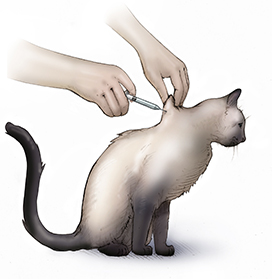Insulin Injections for Your Feline Diabetic
To administer an injection, pull the loose skin between the shoulder blades with one hand. With the other hand, insert the needle directly into the indentation made by holding up the skin, draw back on the plunger slightly, and if no blood appears in the syringe, inject gently.

Tips for Treatment
- You can do it! Treating your cat may sound difficult, but for most owners it soon becomes routine.
- Work very closely with your veterinarian to get the best results for your cat.
- Once your cat has been diagnosed, it’s best to start insulin therapy as soon as possible.
- Home glucose monitoring can be very helpful.
- Tracking your cat’s water intake, activity level, appetite, and weight can be beneficial.
- A low carbohydrate diet helps diabetic cats maintain proper glucose levels.
- With careful treatment, your cat’s diabetes may well go into remission.
- If your cat shows signs of hypoglycemia (lethargy, weakness, tremors, seizures, vomiting) apply honey, a glucose solution, or dextrose gel to the gums and immediately contact a veterinarian.
Possible Complications
Insulin therapy lowers blood glucose, possibly to dangerously low levels. Signs of hypoglycemia include weakness, lethargy, vomiting, lack of coordination, seizures, and coma. Hypoglycemia can be fatal if left untreated, so any diabetic cat that shows any of these signs should be offered its regular food immediately. If the cat does not eat voluntarily, it should be given oral glucose in the form of honey, corn syrup, or proprietary dextrose gels (available at most pharmacies) and brought to a veterinarian immediately. It is important, however, that owners not attempt to force fingers, food, or fluids into the mouth of a convulsing or comatose cat.
Diabetic cats with uncontrolled diabetes may develop a condition known as ketoacidosis. This occus when cells starved for glucose begin to break down fats for energy, a process that creates chemicals called ketones, which make the blood more acidic. Ketoacidosis is considered a medical emergency, and cats diagnosed with this complication require hospitalization for ideal management.
Monitoring Your Cat At Home
Monitoring a diabetic cat at home requires careful attention to a few things. Cats with well-controlled diabetes should maintain a normal activity level and demeanor. Owners should also monitor daily water intake, urine production, appetite, body weight, amount of insulin administered, and urine or blood glucose levels, depending upon how well-controlled a cat’s blood glucose is. Monitoring is best coordinated in close collaboration with your veterinarian.

